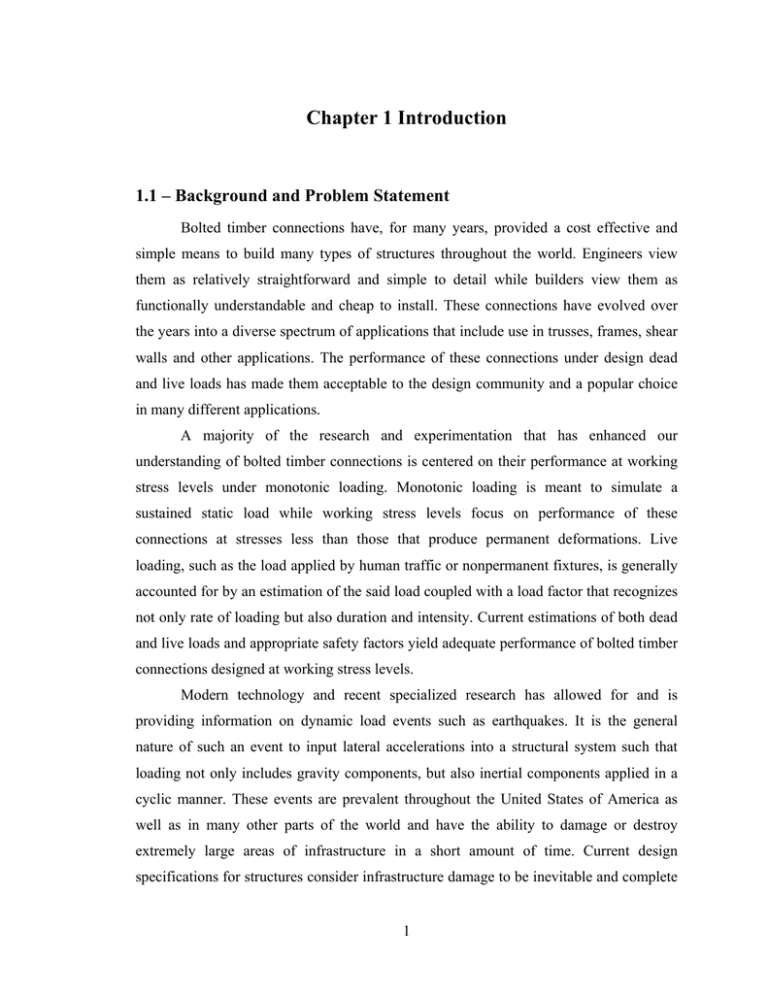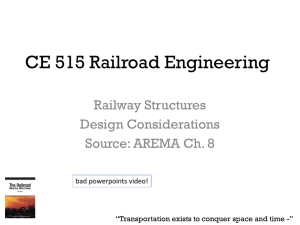Chapter 1 Introduction 1.1 – Background and Problem Statement
advertisement

Chapter 1 Introduction 1.1 – Background and Problem Statement Bolted timber connections have, for many years, provided a cost effective and simple means to build many types of structures throughout the world. Engineers view them as relatively straightforward and simple to detail while builders view them as functionally understandable and cheap to install. These connections have evolved over the years into a diverse spectrum of applications that include use in trusses, frames, shear walls and other applications. The performance of these connections under design dead and live loads has made them acceptable to the design community and a popular choice in many different applications. A majority of the research and experimentation that has enhanced our understanding of bolted timber connections is centered on their performance at working stress levels under monotonic loading. Monotonic loading is meant to simulate a sustained static load while working stress levels focus on performance of these connections at stresses less than those that produce permanent deformations. Live loading, such as the load applied by human traffic or nonpermanent fixtures, is generally accounted for by an estimation of the said load coupled with a load factor that recognizes not only rate of loading but also duration and intensity. Current estimations of both dead and live loads and appropriate safety factors yield adequate performance of bolted timber connections designed at working stress levels. Modern technology and recent specialized research has allowed for and is providing information on dynamic load events such as earthquakes. It is the general nature of such an event to input lateral accelerations into a structural system such that loading not only includes gravity components, but also inertial components applied in a cyclic manner. These events are prevalent throughout the United States of America as well as in many other parts of the world and have the ability to damage or destroy extremely large areas of infrastructure in a short amount of time. Current design specifications for structures consider infrastructure damage to be inevitable and complete 1 Chapter 1 Introduction 2 destruction unacceptable, due to the probable loss of life. The frequency of dynamic loading events in increasingly urbanized areas has raised concerns regarding the adequacy and reliability of bolted timber connections as a result of the lack of information on their performance when exposed to cyclic loading and when stresses exceed allowable stresses. Without a clear understanding of the expected amount of damage the market for bolted timber structures may be adversely affected. To more fully understand the performance of bolted timber connections it is necessary to quantify and record the parameters that directly affect strength and stiffness in a laboratory environment capable of simulating a dynamic event. In particular, it is necessary to determine how current design requirements perform during a dynamic loading event by obtaining information on capacity loads, yielding mechanisms and loads, failure mechanisms, and the group action factor at capacity. This thesis specifically addresses the group action factor, a factor used to account for the unequal distribution of load among bolts in a row, at capacity and its significance in bolted timber connections exposed to cyclic loading. 1.2 – Objectives The objective of this research is to experimentally quantify the group action factor at capacity in multiple-bolt timber connections exposed to cyclic loading. Other subobjectives include: • Experimentally quantify the group action factor at the 5% offset yield strength in multiple-bolt timber connections exposed to cyclic loading. • Experimentally quantify ductility for a range of multiple-bolt connections. • Determine the validity of Yield Limit Model connection capacity and 5% offset yield strength predictions for single-bolt connections exposed to cyclic loading. • Observe and provide information on failure mechanisms. Other useful parameters obtained from this project include: • Hysteretic Energy, • Strain Energy, • Equivalent Viscous Damping, Chapter 1 Introduction • 3 Cyclic Stiffness. 1.3 – Significance Development of the group action factor currently used in the 1997 National Design Specification (NDS) for Wood Construction is based on analysis and modeling of the linear-elastic response of assemblies exposed to monotonic loading. Original motivation for this development addressed concerns that the group action effect, if not accounted for, would cause failures. Current concern points out that failures rarely occur during the linear-elastic response of bolted timber connections and that a capacity based analysis of the group action effect is needed. It is hoped that this research will shift the basis of the group action effect, a quantity associated with safety, from a linearly elastic approach to one based on capacity. 1.4 – Thesis Overview Based on published past research and current design recommendations, Chapter 2 presents a brief review of bolted timber connection performance, testing procedures and current models used to predict connection response. Chapter 3 describes the experimental program including specimen geometry, material, and testing procedure as well as a description of the testing protocols, analysis procedures, material sampling, and material testing. Results and discussion of the monotonic and reversed cyclic tests of bolted timber connections are presented in Chapter 4. The conclusions, which address the objectives, are presented in Chapter 5. Appendix A contains results and load-deflection plots of all monotonic connection tests. Appendix B contains results and load-deflection plots of all cyclic connection tests.




